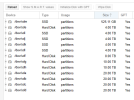I am new to Proxmox and all Virtual Environments, I am also fairly new to RAID configurations. I had a server which previously was a Windows 11Pro, running 4 20TB HDD's in a RAID 5 serving movies and the like to PLEX and Jellyfin. Wasn't an actual server other than this.
As of yesterday, I got my Proxmox installed and all 12 drives installed, the 4 20TB mentioned above, 2 10TB, 1 8TB, 1 4TB HDD's and 4 4TB SSD's. the plan is this: I need to set up PiHole and an Adblocker running a VPN of some sort for all connections through each VM, container, etc... And I am looking to take those 4 20TB HDD's and reuse them for the movie server as they already have the files RAIDed on them. How do I save that information and reconfigure them into this environment without losing the information on them???
Everything else I'd like to do is being put to end after this is addressed as my granddaughter needs her Bluey. LOL
As of yesterday, I got my Proxmox installed and all 12 drives installed, the 4 20TB mentioned above, 2 10TB, 1 8TB, 1 4TB HDD's and 4 4TB SSD's. the plan is this: I need to set up PiHole and an Adblocker running a VPN of some sort for all connections through each VM, container, etc... And I am looking to take those 4 20TB HDD's and reuse them for the movie server as they already have the files RAIDed on them. How do I save that information and reconfigure them into this environment without losing the information on them???
Everything else I'd like to do is being put to end after this is addressed as my granddaughter needs her Bluey. LOL


